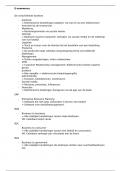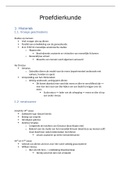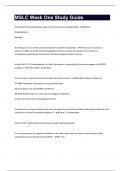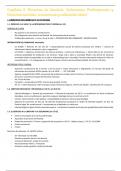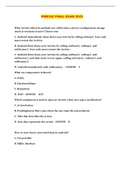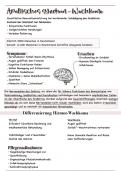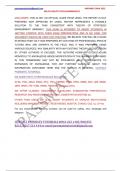ROMAN LAW 271
BA Law II
Stellenbosch University
Sune-Mari
,INTRODUCTION TO ROMAN LAW
WHY DO WE STUDY THE ROMAN LAW OF THINGS?
• Important source of modern property law
o Basic concepts are stilled used in SA law (such as clear distinction
between real and personal rights)
• Institutional framework
o Gaius divided private law into three section: personae, res and actiones
ROMAN LAW OF THINGS
, Introduction to Roman Law 2
ROLE AND PLACE OF LAW OF THINGS
• Why the need for a Law of Things?
o As society developed to allow a specific person to exclusively use a specific
thing for himself, there developed a need for rules regulating such exclusive
use – determining what a person may or may not do with his thing as well as
the consequences of another person interfering with the exclusive use
o Ownership = strongest right over a thing + strongest protection against third
parties
▪ Protected by rei vindication
o Right of ownership consists of right to use a thing (ius iutendi), right to
receive its fruits and right to destroy or alienate a thing
• Role of the law of things
o Regulates the relationship between persons and things (real/absolute
relationships)
o Absolute = the holder of the real right is protected against infringement
regardless of the identity of the infringer
• Foundation
o Recognition of real actions versus personal actions
, Concept and Classification of Things 3
CONCEPT AND CLASSIFICATION OF THINGS
THE DEFINITION OF A THING
• A “res” was something that could form part of a person’s patrimony – any asset with
economic value (included corporeal [res corporealis] and incorporeal things [res
incorporealis])
• Only corporeal things could be possessed or could be the subject of acquisition of
ownership through usucapio (prescription).
CLASSIFICATION OF THINGS
Res Communes
• Things that belong to everyone (things common to all) and could be used and enjoyed by
everyone for example the air, the sea, or running water
Res Publicae
• Things belonging to the state such as “public roads, harbours, ports, certain rivers, bridges,
and enemy property capture in military action”. It also included “provincial land, land in
provinces outside Italy.”
Res Universitas
• Res universitas were things that belonged to a specific city or community for the use of the
inhabitants of that city or community for example theatres, parks, racecourses, and stadia.
Res Nullius
•Things that belonged to no one. It was possible to acquire dominium over certain things in this category for example wild animals. However,
private ownership of other things within the category res nullius could not be obtained.
•a) Res sanctae refers to things under the protection of the gods for example city walls and -gates.
•b) Res religiosae refers to things dedicated to the gods of the underworld such as graves, graveyards, and tombs.
•c) Res sacrae refers to things dedicated to the heavenly gods for example temples, altars, basilicas, sacred groves, and temple equipment
Seashore
• “[e]veryone… had the right of access to the seashore… No one could acquire any part of the
seashore but shelters and similar erections could be built, if authorized and became the
property of the builder…”
PUBLIC THINGS
, Concept and Classification of Things 4
It is important to be able to identify whether something can be classified as a
public thing – it has implications for ownership rights (individual ownership not
possible) as well as the validity of certain contracts.
PRIVATE THINGS
RES MOBILES AND RES IMMOBILES
• Moveable v immoveable things (immoveable: attached to the land)
• Relevant for determining the period required to acquire ownership through
prescription, for possessory interdicts, and the constitution of certain servitudes
RES FUNGIBILES & RES NON FUNGIBILES
• Res fungible = fungible things = things that can be replaced + only indicated by a type
• Res non fungible = non fungible things = specific things with a separate identity and a
degree of permanence
• The types of contract concluded regarding fungible things and non-fungible things
differed
RES MANCIPI & RES NEC MANCIPI
• This distinction was relevant for how dominium (Roman ownership) could be
transferred.
• Res mancipi were transferred through the formal methods (mancipatio or in iure
cessio) in terms of ius civile – thus only available to Roman citizens or foreigners with
commercium.
o Res mancipi was a limited category, a closed list.
o Res mancipi were the things that determined the wealth of citizens for
purposes of the census.
o Most important things in the early agrarian society in other words slaves,
beasts of draught and burden, certain rural praedial servitudes (iter, actus,
via and aquaeductus), and land in Italy.
• Res nec mancipi was simply everything else, everything not included in the closed
list of res mancipi.
o Dominium (Roman ownership) of res nec mancipi could be transferred
through the informal method of acquisition traditio.
, Concept and Classification of Things 5
DIVISIBLE AND NON-DIVISIBLE THINGS
• Relevant for the dissolution of co-ownership.
• Divisible things are things that can be divided without diminishing their value such as
land, or a roll of material. Indivisible things are things that cannot be divided such as
a slave or a painting.
, Real vs Personal Actions 6
REAL VS PERSONAL ACTIONS
The foundation of the Roman law of things was the recognition of real actions as opposed to
personal actions. In Roman law, as opposed to modern law, the focus was not on the right,
but rather from a procedural perspective – where there is a remedy there is a right (ubi
remedium ibi ius).
• An actio in personam (personal action) is an action in terms of which you litigate
against someone based on, for example, a contract or a delict.
• An actio in rem is a claim that we are entitled to a corporeal thing (that it is ours), or
that we are entitled to a particular right in the property. It is a claim for direct
control over a thing.
ACTIO IN REM
• Instituted against the res itself / anyone in possession of the res
• Thing can be claimed wherever found
• Action in rem concerned an absolute patrimonial relation
o Originally covered an action through which a dispute over ownership of a res
was resolved, the rei vindication
▪ The claimant laid claim to direct control over the res through the
meum esse– formula which can be translated as “I say that this res is
mine according to the law of us Romans”. The uttering of the formula
was accompanied by grabbing the res or a symbol thereof.
▪ In case of a movable thing, the thing had to be brought before the
praetor before instituting the action. In the case of an immovable
thing, the action was initially instituted on the property itself – later
used a symbol when instating action before the praetor.
▪ Identity of other party not mentioned
• Defendant had the following choices:
o The defendant could institute a contravindicatio – a counterclaim that the res
is his
o The defendant could acknowledge the claim resulting in the claimant’s claim
becoming indisputable
o The defendant could refuse to get involved. In which case the action was
considered to be undefended.
, Real vs Personal Actions 7
• In Justinianic law, an actio in rem could be used to realise all absolute rights. Later
the actio in rem developed into the real right (ius in re). Thus, it is the foundation for
the concept of real right.
ACTIO IN PERSONAM
• An actio in personam was an action against a specific person. Thus, the identity of
the other party was important.
• A specific person was charged before the court. An example of the formula used was
“I claimthat you owe me 10 thousand sesterces”. There exists a legal nexus (bond)
between the claimant and the specific person that had to deliver the performance.
• Here the defendant did not have a choice. The defendant had to enter the dispute
otherwise it was seen as tacit acknowledgement of the claim.
• The actio in personam later developed into the ius in personam (personal right) – a
right to performance.
, Ownership 8
OWNERSHIP
NATURE OF OWNERSHIP
• The Romanist Schulz describes ownership as “that right over a corporeal thing, which
on principle endows its holder with full power over the thing, although this power
may be subject to various limitations.” (right over a thing which gives power over
said thing)
• There was an undefined concept of ownership from the use of expressions such as
that “this thing is mine” (hanc rem meam esse = THIS IS MY BUSINESS) and from the
wording of the classical owner’s remedy, the rei vindication.
• A precise definition of the Roman concept of ownership is impossible because
ownership does not have a precisely determined content.
o The content of ownership can differ from full use and enjoyment on the one
hand to nuda proprietas (bare ownership) on the other where the owner’s
right only encompasses the fact that his/her rights will revive as the rights of
others lapse.
• Limited real rights (iura in re aliena) has specific and defined content.
• Owners had all competencies (for example alienation of the res, the use of the res,
the right to draw fruits etc) regarding his res, provided it was not limited by the law,
the public order, or the rights of others.
LIMITATIONS
• Sacrosanctus (divine law/power), but still subject to limitations (limited by public
law)
• Had to respect the rights of others through enjoyment of own right of ownership
• Could not bury dead in city
• Land adjacent to damaged road had to allow walkway
• Someone who exercises his right cannot act improperly
• Limited by physical boundaries
• Ownership could also be limited by the rights of others.
TYPES OF OWNERSHIP
DOMINIUM (EX IURE QUIRITIUM) (ACCORDING TO THE LAW OF THE ROMANS)
, Ownership 9
• Exercise DOMINIUM from the law of the Quirites
• Dominium was ownership according to Roman law (ius civile)
• Thus, it was ownership for Roman citizens [or foreigners with commercium], in terms
of Roman law, over objects under the control of the paterfamilias.
• It could be acquired over…
o res corporales (but not over res incorporales)
o land (and buildings) in Italy (but not over land in the provinces)
o over all types of movables (provided the movables could be classified as
private things)
o over both res mancipi and res nec mancipi, i.e. things in private ownership.
PRAETORIAN OWNERSHIP (BONITARY OWNERSHIP)
• Praetorian protection
o If the parties disregarded the strict formalities associated with either
mancipatio or in iure cessio, no transfer of dominium occurred.
o However, the transferee did receive protection from the praetor.
o It was a new type of ownership and was regarded as an interim measure until
dominium was acquired (usually through prescription).
▪ Dominium of res mancipi could only be transferred through the
formal methods of transfer mancipatio or in iure cessio.
• Flowed from the distinction between res mancipi and res nec mancipi.
• It was a right like dominium due to the praetor’s protective measures.
CO-OWNERSHIP
• “implies that a right to one thing vested simultaneously in several owners.”
• Co-ownership could be established through…
o Consortium usually came about through testamentary succession (brothers
inheriting from their paterfamilias), but it could also be created artificially.
o Communio pro indiviso (sharing in common) or condominium (notify) was as
a rule established voluntarily by partners engaged in a business venture.
BA Law II
Stellenbosch University
Sune-Mari
,INTRODUCTION TO ROMAN LAW
WHY DO WE STUDY THE ROMAN LAW OF THINGS?
• Important source of modern property law
o Basic concepts are stilled used in SA law (such as clear distinction
between real and personal rights)
• Institutional framework
o Gaius divided private law into three section: personae, res and actiones
ROMAN LAW OF THINGS
, Introduction to Roman Law 2
ROLE AND PLACE OF LAW OF THINGS
• Why the need for a Law of Things?
o As society developed to allow a specific person to exclusively use a specific
thing for himself, there developed a need for rules regulating such exclusive
use – determining what a person may or may not do with his thing as well as
the consequences of another person interfering with the exclusive use
o Ownership = strongest right over a thing + strongest protection against third
parties
▪ Protected by rei vindication
o Right of ownership consists of right to use a thing (ius iutendi), right to
receive its fruits and right to destroy or alienate a thing
• Role of the law of things
o Regulates the relationship between persons and things (real/absolute
relationships)
o Absolute = the holder of the real right is protected against infringement
regardless of the identity of the infringer
• Foundation
o Recognition of real actions versus personal actions
, Concept and Classification of Things 3
CONCEPT AND CLASSIFICATION OF THINGS
THE DEFINITION OF A THING
• A “res” was something that could form part of a person’s patrimony – any asset with
economic value (included corporeal [res corporealis] and incorporeal things [res
incorporealis])
• Only corporeal things could be possessed or could be the subject of acquisition of
ownership through usucapio (prescription).
CLASSIFICATION OF THINGS
Res Communes
• Things that belong to everyone (things common to all) and could be used and enjoyed by
everyone for example the air, the sea, or running water
Res Publicae
• Things belonging to the state such as “public roads, harbours, ports, certain rivers, bridges,
and enemy property capture in military action”. It also included “provincial land, land in
provinces outside Italy.”
Res Universitas
• Res universitas were things that belonged to a specific city or community for the use of the
inhabitants of that city or community for example theatres, parks, racecourses, and stadia.
Res Nullius
•Things that belonged to no one. It was possible to acquire dominium over certain things in this category for example wild animals. However,
private ownership of other things within the category res nullius could not be obtained.
•a) Res sanctae refers to things under the protection of the gods for example city walls and -gates.
•b) Res religiosae refers to things dedicated to the gods of the underworld such as graves, graveyards, and tombs.
•c) Res sacrae refers to things dedicated to the heavenly gods for example temples, altars, basilicas, sacred groves, and temple equipment
Seashore
• “[e]veryone… had the right of access to the seashore… No one could acquire any part of the
seashore but shelters and similar erections could be built, if authorized and became the
property of the builder…”
PUBLIC THINGS
, Concept and Classification of Things 4
It is important to be able to identify whether something can be classified as a
public thing – it has implications for ownership rights (individual ownership not
possible) as well as the validity of certain contracts.
PRIVATE THINGS
RES MOBILES AND RES IMMOBILES
• Moveable v immoveable things (immoveable: attached to the land)
• Relevant for determining the period required to acquire ownership through
prescription, for possessory interdicts, and the constitution of certain servitudes
RES FUNGIBILES & RES NON FUNGIBILES
• Res fungible = fungible things = things that can be replaced + only indicated by a type
• Res non fungible = non fungible things = specific things with a separate identity and a
degree of permanence
• The types of contract concluded regarding fungible things and non-fungible things
differed
RES MANCIPI & RES NEC MANCIPI
• This distinction was relevant for how dominium (Roman ownership) could be
transferred.
• Res mancipi were transferred through the formal methods (mancipatio or in iure
cessio) in terms of ius civile – thus only available to Roman citizens or foreigners with
commercium.
o Res mancipi was a limited category, a closed list.
o Res mancipi were the things that determined the wealth of citizens for
purposes of the census.
o Most important things in the early agrarian society in other words slaves,
beasts of draught and burden, certain rural praedial servitudes (iter, actus,
via and aquaeductus), and land in Italy.
• Res nec mancipi was simply everything else, everything not included in the closed
list of res mancipi.
o Dominium (Roman ownership) of res nec mancipi could be transferred
through the informal method of acquisition traditio.
, Concept and Classification of Things 5
DIVISIBLE AND NON-DIVISIBLE THINGS
• Relevant for the dissolution of co-ownership.
• Divisible things are things that can be divided without diminishing their value such as
land, or a roll of material. Indivisible things are things that cannot be divided such as
a slave or a painting.
, Real vs Personal Actions 6
REAL VS PERSONAL ACTIONS
The foundation of the Roman law of things was the recognition of real actions as opposed to
personal actions. In Roman law, as opposed to modern law, the focus was not on the right,
but rather from a procedural perspective – where there is a remedy there is a right (ubi
remedium ibi ius).
• An actio in personam (personal action) is an action in terms of which you litigate
against someone based on, for example, a contract or a delict.
• An actio in rem is a claim that we are entitled to a corporeal thing (that it is ours), or
that we are entitled to a particular right in the property. It is a claim for direct
control over a thing.
ACTIO IN REM
• Instituted against the res itself / anyone in possession of the res
• Thing can be claimed wherever found
• Action in rem concerned an absolute patrimonial relation
o Originally covered an action through which a dispute over ownership of a res
was resolved, the rei vindication
▪ The claimant laid claim to direct control over the res through the
meum esse– formula which can be translated as “I say that this res is
mine according to the law of us Romans”. The uttering of the formula
was accompanied by grabbing the res or a symbol thereof.
▪ In case of a movable thing, the thing had to be brought before the
praetor before instituting the action. In the case of an immovable
thing, the action was initially instituted on the property itself – later
used a symbol when instating action before the praetor.
▪ Identity of other party not mentioned
• Defendant had the following choices:
o The defendant could institute a contravindicatio – a counterclaim that the res
is his
o The defendant could acknowledge the claim resulting in the claimant’s claim
becoming indisputable
o The defendant could refuse to get involved. In which case the action was
considered to be undefended.
, Real vs Personal Actions 7
• In Justinianic law, an actio in rem could be used to realise all absolute rights. Later
the actio in rem developed into the real right (ius in re). Thus, it is the foundation for
the concept of real right.
ACTIO IN PERSONAM
• An actio in personam was an action against a specific person. Thus, the identity of
the other party was important.
• A specific person was charged before the court. An example of the formula used was
“I claimthat you owe me 10 thousand sesterces”. There exists a legal nexus (bond)
between the claimant and the specific person that had to deliver the performance.
• Here the defendant did not have a choice. The defendant had to enter the dispute
otherwise it was seen as tacit acknowledgement of the claim.
• The actio in personam later developed into the ius in personam (personal right) – a
right to performance.
, Ownership 8
OWNERSHIP
NATURE OF OWNERSHIP
• The Romanist Schulz describes ownership as “that right over a corporeal thing, which
on principle endows its holder with full power over the thing, although this power
may be subject to various limitations.” (right over a thing which gives power over
said thing)
• There was an undefined concept of ownership from the use of expressions such as
that “this thing is mine” (hanc rem meam esse = THIS IS MY BUSINESS) and from the
wording of the classical owner’s remedy, the rei vindication.
• A precise definition of the Roman concept of ownership is impossible because
ownership does not have a precisely determined content.
o The content of ownership can differ from full use and enjoyment on the one
hand to nuda proprietas (bare ownership) on the other where the owner’s
right only encompasses the fact that his/her rights will revive as the rights of
others lapse.
• Limited real rights (iura in re aliena) has specific and defined content.
• Owners had all competencies (for example alienation of the res, the use of the res,
the right to draw fruits etc) regarding his res, provided it was not limited by the law,
the public order, or the rights of others.
LIMITATIONS
• Sacrosanctus (divine law/power), but still subject to limitations (limited by public
law)
• Had to respect the rights of others through enjoyment of own right of ownership
• Could not bury dead in city
• Land adjacent to damaged road had to allow walkway
• Someone who exercises his right cannot act improperly
• Limited by physical boundaries
• Ownership could also be limited by the rights of others.
TYPES OF OWNERSHIP
DOMINIUM (EX IURE QUIRITIUM) (ACCORDING TO THE LAW OF THE ROMANS)
, Ownership 9
• Exercise DOMINIUM from the law of the Quirites
• Dominium was ownership according to Roman law (ius civile)
• Thus, it was ownership for Roman citizens [or foreigners with commercium], in terms
of Roman law, over objects under the control of the paterfamilias.
• It could be acquired over…
o res corporales (but not over res incorporales)
o land (and buildings) in Italy (but not over land in the provinces)
o over all types of movables (provided the movables could be classified as
private things)
o over both res mancipi and res nec mancipi, i.e. things in private ownership.
PRAETORIAN OWNERSHIP (BONITARY OWNERSHIP)
• Praetorian protection
o If the parties disregarded the strict formalities associated with either
mancipatio or in iure cessio, no transfer of dominium occurred.
o However, the transferee did receive protection from the praetor.
o It was a new type of ownership and was regarded as an interim measure until
dominium was acquired (usually through prescription).
▪ Dominium of res mancipi could only be transferred through the
formal methods of transfer mancipatio or in iure cessio.
• Flowed from the distinction between res mancipi and res nec mancipi.
• It was a right like dominium due to the praetor’s protective measures.
CO-OWNERSHIP
• “implies that a right to one thing vested simultaneously in several owners.”
• Co-ownership could be established through…
o Consortium usually came about through testamentary succession (brothers
inheriting from their paterfamilias), but it could also be created artificially.
o Communio pro indiviso (sharing in common) or condominium (notify) was as
a rule established voluntarily by partners engaged in a business venture.

